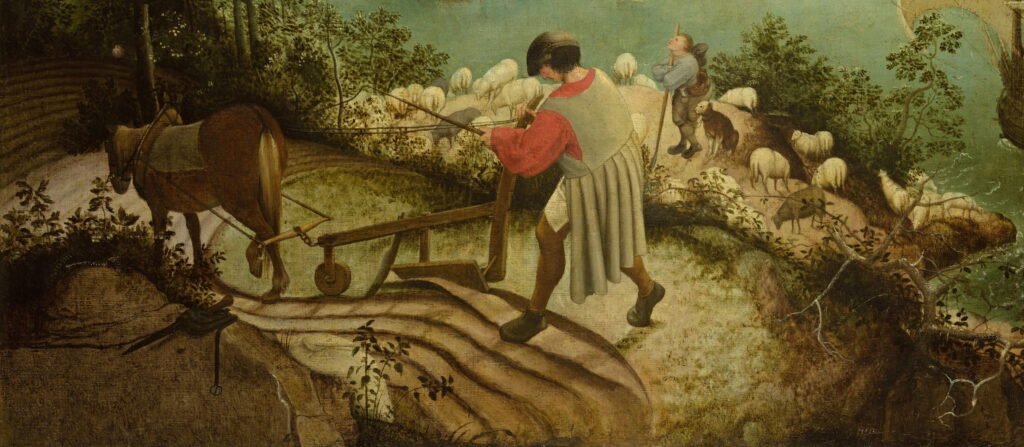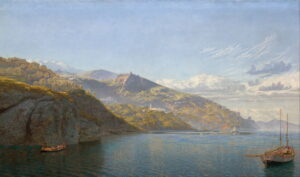The Real Country: 1 Under the plough

By 1500, towns remained small throughout Europe. These days, a populated area with up to twenty thousand inhabitants is recognised as a small town or large village; France had only fourteen towns larger than that, and England had just one, London. The contrast between urban and rural life is illustrated well by some of the most remarkable frescoes from before the Renaissance, painted by Ambrogio Lorenzetti in the Palazzo Pubblico in Siena in 1338-39.
Ambrogio Lorenzetti (1290–1348), Effects of Good Government in the City (1338-39), fresco, dimensions not known, Fondazione Musei Senesi, Siena, Italy. Wikimedia Commons.
These frescoes for the Council Room are overt social and political commentary forming a lesson in civics. In six different scenes, he shows allegories and examples of good and bad government in the city and country. The Effects of Good Government in the City (1338-39) is modelled after Siena, and intended to illustrate peaceful prosperity resulting from wise politics. There are no beggars, no street crime. Life is peaceful and orderly, and the citizens are prosperous and healthy. During its golden age before the Black Death in 1348, Siena reached a population of fifty thousand, huge by the standards of the day, and similar to its present size.
Ambrogio Lorenzetti (1290–1348), Effects of Good Government in the Countryside (1338-39), fresco, dimensions not known, Fondazione Musei Senesi, Siena, Italy. Wikimedia Commons.
Essential to the prosperity of the city were the Effects of Good Government in the Countryside (1338-39), where crops were grown and livestock farmed to feed the city and provide materials for its trade. This is a neat, almost manicured countryside with a patchwork of fields, and all the peasants fully occupied and working hard.
Almost all farms combined the rearing of livestock such as cattle with the production of cereals and vegetables, and few were able to specialise in either, or in a single crop. Almost all had the joint tasks of feeding locals at a subsistence level and trying to grow a surplus to sell into the city.
Key to the growing of crops was soil quality. The only fertiliser available to increase soil nutrients came from livestock, and the only way to prepare the soil to give the best yields was ploughing. Little land at this time had any form of drainage, so in many parts of Europe it was wet for much of the year. That made the soil heavy, particularly if it was clay, and ploughing was used to break the soil up into a fine tilth, and to build that into ridges and furrows to help it drain.
Pieter Brueghel the Elder (1526/1530–1569), Landscape with the Fall of Icarus (copy of original from c 1558), oil on canvas mounted on wood, 73.5 × 112 cm, Royal Museums of Fine Arts of Belgium, Brussels. Wikimedia Commons.
This is shown in the foreground of this copy, possibly painted by de Momper, of Brueghel’s Landscape with the Fall of Icarus from about 1558. Although its landscape is fictitious, the ploughman in the foreground appears true to life, and his plough typical of much of Europe at that time, as shown in the detail below.
Pieter Brueghel the Elder (1526/1530–1569), Landscape with the Fall of Icarus (copy of original from c 1558)(detail), oil on canvas mounted on wood, 73.5 × 112 cm, Royal Museums of Fine Arts of Belgium, Brussels. Wikimedia Commons.
At the very front of the plough is a small jockey wheel, behind which is a vertical metal blade, the coulter or skeith, whose task is to cut into the ground just ahead of the share, a wooden board that turns the surface of the earth to one side. The effect on the ground is to cut furrows into its surface and turn the soil onto ridges. When repeated five or more times over the course of the autumn and winter, this could build ridges high enough for the water to drain into the furrows, and coupled with the action of ground frost could break up even heavy clays into a tilth ready for sowing in the Spring.
An interesting detail revealed in Brueghel’s painting is how the course of the plough is curved, and swings wide to make the turn, as I explained in the introduction to this series last week.
Ploughing required considerable pulling power, usually delivered by a team of oxen, generally bullocks (castrated males), rather than horses. Where the soil was heavy going, a team of six or even eight were required. Even after the introduction of the heavy mould-board or turning plough in the eighteenth century, it wasn’t unusual to see large teams still in use.
Rosa Bonheur (1822–1899), Ploughing in Nevers (1849), oil on canvas, 134 x 260 cm, Musée d’Orsay, Paris. Wikimedia Commons.
Rosa Bonheur’s Ploughing in Nevers, painted in 1849, shows two teams of six oxen each drawing more modern mould-board ploughs through heavy soil to build high ridges.
Eugène Burnand (1850–1921), Ploughing in the Jorat (1916), oil on canvas, 270 x 620 cm, location not known. Wikimedia Commons.
Further improvements in plough design and possibly lighter soil enabled the reduced team seen in Eugène Burnand’s Ploughing in the Jorat in 1916, with a single horse leading a pair of oxen.
Grant Wood (1891–1942), Fall Plowing (1931), oil, dimensions and location not known. Wikimedia Commons.
By 1931, when Grant Wood painted Fall Plowing, the recently-developed walking plough had a steel ploughshare, bringing a major advance in cultivating the prairie in Iowa. By this time many farms had started to replace their horses and oxen with tractors, a subject I’ll return to later in this series.
Ploughing was arduous work for all concerned, and working even relatively small areas of arable land was time-consuming. In more northerly latitudes, winter days are short, and it wasn’t easy to find sufficient daylight to plough enough land five times over for the following year’s crops. Arable farming demanded a great deal of time and effort year-round.




